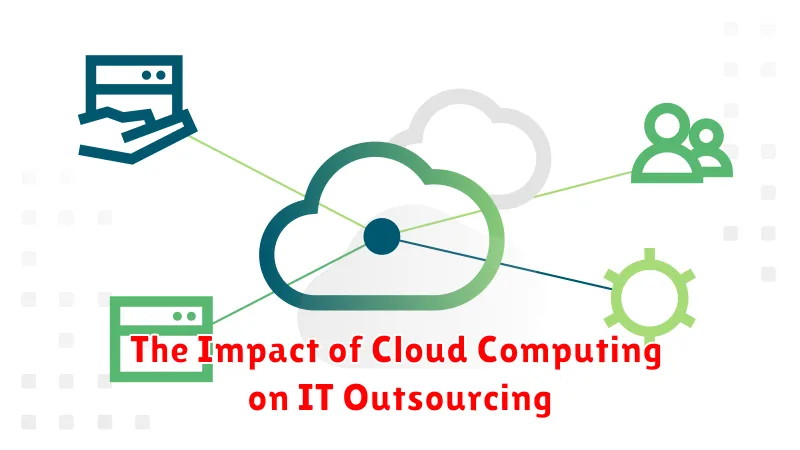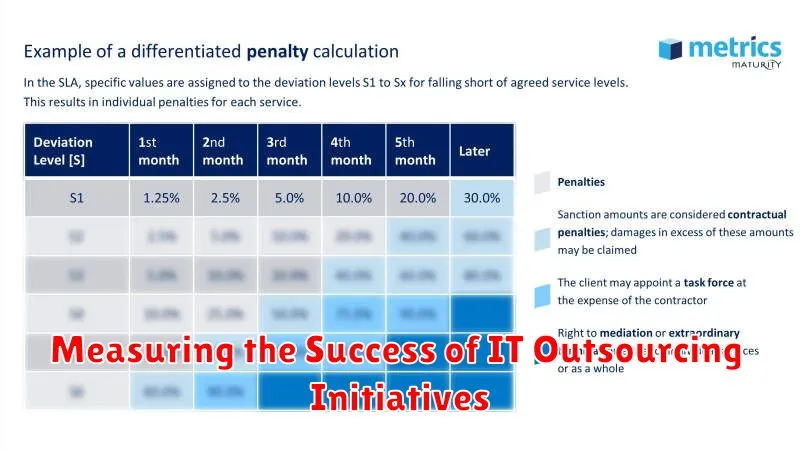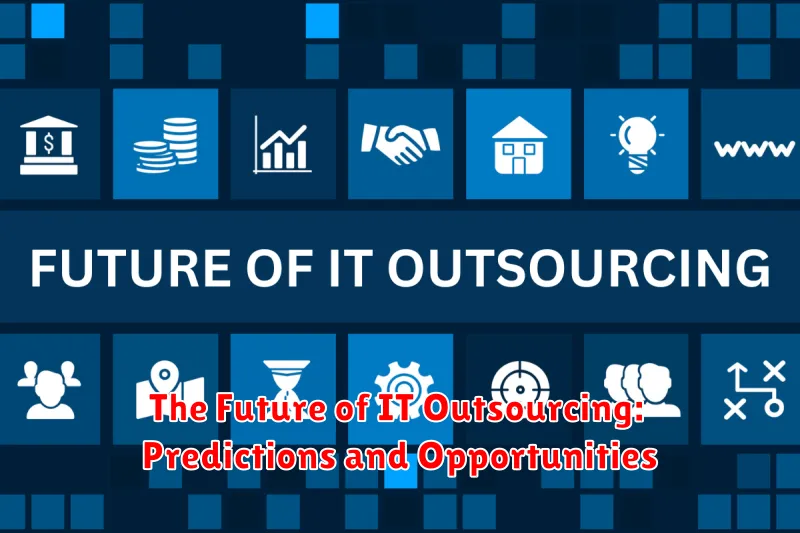In today’s fast-paced digital landscape, businesses are constantly looking for ways to stay ahead of the competition. One of the most effective ways to achieve this is through strategic outsourcing. By leveraging the expertise and resources of IT outsourcing companies, businesses can gain access to a wide range of services that can help them improve their operations, reduce costs, and enhance their overall efficiency. But navigating the world of IT outsourcing can be daunting, with numerous providers and service offerings available. This comprehensive guide will provide you with valuable insights and actionable strategies to help you make informed decisions and achieve your outsourcing goals.
From cloud computing to software development, data analytics to cybersecurity, IT outsourcing companies offer a vast array of services that can cater to your specific needs. By understanding the different types of outsourcing models, the key factors to consider when selecting a provider, and the best practices for successful outsourcing partnerships, you can unlock the full potential of this transformative strategy. This guide will provide you with a roadmap for navigating the complexities of IT outsourcing, empowering you to make strategic decisions that drive your business forward.
Types of IT Outsourcing Models: Finding the Right Fit
Navigating the world of IT outsourcing can feel overwhelming, especially with the various models available. But don’t worry, understanding the different types of outsourcing models can help you find the perfect fit for your organization’s needs. Choosing the right model is crucial for success, ensuring you get the best value and optimized results.
Here’s a breakdown of common IT outsourcing models:
1. Onshore Outsourcing
When you outsource to a company within your own country, it’s called onshore outsourcing. This option offers advantages like cultural familiarity, shared time zones, and a similar legal framework. It can also be beneficial for projects requiring high levels of security or sensitive data, as regulations are well-understood.
2. Offshore Outsourcing
Offshore outsourcing involves partnering with a company in a different country, often in regions like India, China, or the Philippines. This model typically offers lower labor costs, access to specialized skillsets, and the ability to operate 24/7. However, it can present challenges like language barriers, time zone differences, and cultural variations.
3. Nearshore Outsourcing
Nearshore outsourcing strikes a balance between onshore and offshore. You partner with a company in a neighboring country, often with similar cultural values and time zones. This approach can provide cost-effective solutions while minimizing communication barriers and cultural misunderstandings.
4. Outtasking
Outtasking involves outsourcing specific tasks or projects to independent contractors or freelancers. This model offers flexibility, cost-effectiveness, and the ability to tap into specialized expertise. However, managing individual contractors and ensuring project quality can be challenging.
5. Managed Services
Managed services involve outsourcing a complete function or department to a third-party provider. The provider takes responsibility for all aspects of the service, including infrastructure, operations, and maintenance. This model frees up your internal resources, allowing you to focus on core competencies. However, it can require significant upfront investment and relinquishing some control.
6. Business Process Outsourcing (BPO)
BPO involves outsourcing non-core business processes, such as customer service, accounting, or human resources. This model allows companies to streamline operations, reduce costs, and focus on their core strengths. BPO can encompass various service areas, including IT, finance, and human resources.
Finding the Right Fit
The best outsourcing model for your organization depends on various factors, including:
- Budget
- Project scope and complexity
- Required skillsets
- Data security and compliance requirements
- Cultural considerations
- Internal resources and expertise
By carefully evaluating your needs and the different outsourcing models available, you can make an informed decision that optimizes your IT strategy and delivers exceptional results.
Benefits of Outsourcing IT Functions
Outsourcing IT functions can be a strategic decision for businesses of all sizes, offering a wide range of benefits that can significantly improve operational efficiency, reduce costs, and enhance overall competitiveness. Here are some of the key advantages of outsourcing IT:
Cost Savings
One of the most significant benefits of IT outsourcing is the potential for substantial cost savings. By outsourcing, businesses can eliminate the need to hire, train, and manage in-house IT staff, as well as the associated costs of infrastructure, software, and maintenance. This can free up valuable resources that can be allocated to other strategic initiatives.
Access to Expertise
Outsourcing provides access to specialized IT expertise that may not be readily available within the organization. By partnering with experienced IT outsourcing companies, businesses can tap into a pool of skilled professionals with deep knowledge and experience in various IT domains, such as cybersecurity, cloud computing, and data management.
Enhanced Focus on Core Business
Outsourcing IT functions allows businesses to focus their resources and efforts on their core business activities. By offloading IT responsibilities, businesses can free up time and energy to concentrate on developing new products and services, expanding into new markets, and enhancing customer satisfaction.
Improved Scalability and Flexibility
Outsourcing provides businesses with the flexibility to scale their IT resources up or down as needed. This is particularly beneficial for businesses experiencing rapid growth or fluctuations in workload. By leveraging the resources of an outsourcing provider, businesses can easily adjust their IT capacity to meet evolving demands.
Increased Efficiency and Productivity
By outsourcing IT functions, businesses can streamline their IT operations and improve efficiency. Outsourcing providers often have standardized processes and best practices in place, which can help to optimize IT service delivery and reduce bottlenecks. This can lead to faster turnaround times, improved performance, and increased productivity.
Enhanced Security
Cybersecurity is a critical concern for businesses of all sizes. Outsourcing IT functions to a reputable provider can enhance security by leveraging their expertise, resources, and best practices. Outsourcing providers often have advanced security measures in place, such as firewalls, intrusion detection systems, and data encryption, which can help to protect businesses from cyber threats.
24/7 Support
Many outsourcing providers offer 24/7 support, ensuring that businesses have access to IT assistance whenever they need it. This is particularly beneficial for businesses with global operations or those that require continuous IT availability.
In conclusion, outsourcing IT functions can provide a wide range of benefits that can help businesses optimize their IT operations, reduce costs, enhance efficiency, and gain a competitive advantage. By carefully evaluating their IT needs and selecting the right outsourcing partner, businesses can effectively leverage outsourcing to achieve their strategic goals.
Key Considerations When Selecting an IT Outsourcing Company
Navigating the world of IT outsourcing companies can seem overwhelming. With numerous providers offering a wide range of services, it’s crucial to have a clear understanding of your needs and priorities before making a decision. To help you streamline the selection process, here are some key considerations:
1. Define Your Needs and Requirements
Before you start researching, take the time to clearly define your IT outsourcing needs. What specific services are you looking for? What are your budget constraints? What are your technical requirements? Having a well-defined scope will allow you to narrow down your search and identify providers that align with your needs.
2. Experience and Expertise
Look for companies with proven experience in your industry and a strong track record of success. Consider their expertise in the specific technologies you require, such as cloud computing, cybersecurity, or data analytics. Research their client base and testimonials to gauge their capabilities.
3. Communication and Collaboration
Effective communication is essential for a successful outsourcing partnership. Choose a company that is responsive, transparent, and proactive in its communication. Consider their communication channels, language proficiency, and cultural understanding to ensure seamless collaboration.
4. Security and Data Protection
Data security should be a top priority. Inquire about the provider’s security protocols, certifications, and compliance with relevant regulations. Understand their approach to data privacy, disaster recovery, and business continuity planning.
5. Cost and Value
While cost is an important factor, don’t solely focus on the lowest price. Consider the long-term value the provider offers, including their expertise, experience, and ability to deliver high-quality results. Request detailed proposals and compare pricing models to ensure a fair and transparent agreement.
6. Flexibility and Scalability
Your business needs may evolve over time. Choose a company that offers flexibility and scalability to adapt to changing requirements. They should be able to adjust their service offerings and resources as your needs grow.
7. Cultural Alignment
Consider the company’s culture and values. Do they align with your organization’s culture? A strong cultural fit can foster trust and collaboration, leading to a more successful partnership.
By carefully considering these key factors, you can make an informed decision and select an IT outsourcing company that meets your specific requirements and helps you achieve your business goals.
Best Practices for Successful IT Outsourcing Partnerships
In today’s competitive business landscape, companies are increasingly turning to IT outsourcing to streamline operations, access specialized skills, and achieve cost savings. However, a successful IT outsourcing partnership requires careful planning, clear communication, and a commitment to collaboration. Here are some best practices to ensure a mutually beneficial and long-lasting relationship with your chosen IT outsourcing partner.
1. Define Clear Objectives and Scope: Before embarking on the outsourcing journey, it’s crucial to define your business objectives and the specific scope of work that will be outsourced. What are your key performance indicators (KPIs)? What are your expected outcomes? Clearly outlining these expectations ensures that both parties are aligned on the goals and deliverables.
2. Choose the Right Partner: Not all IT outsourcing companies are created equal. Carefully evaluate potential partners based on their expertise, experience, industry knowledge, and cultural fit. Look for a partner that aligns with your company’s values and has a proven track record of success.
3. Establish Strong Communication Channels: Open and regular communication is vital for any successful partnership. Establish clear communication channels and protocols to ensure that information flows seamlessly between your internal team and the outsourcing provider. This includes regular meetings, progress reports, and readily accessible contact points.
4. Implement Robust Governance: To ensure alignment and accountability, establish a robust governance structure. Define roles and responsibilities, establish clear escalation procedures, and implement regular performance reviews. This framework helps maintain transparency and ensures that the partnership remains on track.
5. Foster a Collaborative Culture: Building a successful outsourcing partnership requires a collaborative approach. Encourage knowledge sharing, cross-functional communication, and a willingness to work together towards common goals. This collaborative spirit enhances communication, problem-solving, and the overall success of the partnership.
6. Prioritize Data Security and Compliance: Data security and compliance are paramount in any IT outsourcing engagement. Ensure that your chosen partner has robust security measures in place and complies with relevant industry regulations. Establish clear data sharing protocols and ensure that all data is handled with the utmost care.
7. Invest in Ongoing Relationship Management: The success of an IT outsourcing partnership requires ongoing investment in relationship management. Regularly review the partnership, address any issues promptly, and actively seek ways to improve the collaboration. This continuous effort strengthens the bond between you and your outsourcing partner.
By adhering to these best practices, organizations can maximize the value of their IT outsourcing partnerships, achieve their business objectives, and build lasting, mutually beneficial relationships with their chosen outsourcing providers.
Managing Risks Associated with IT Outsourcing
Outsourcing IT functions can bring significant benefits, such as cost savings and access to specialized expertise. However, it also introduces new risks that need careful consideration and management. By understanding these risks and implementing appropriate mitigation strategies, businesses can reap the rewards of outsourcing while minimizing potential drawbacks.
Data Security and Privacy
One of the biggest concerns for organizations considering outsourcing is data security. Outsourcing IT functions means entrusting sensitive data to third-party providers. To mitigate this risk, businesses should carefully select vendors with strong security protocols and certifications, such as ISO 27001. They should also implement robust data encryption measures and have clear data access and usage agreements in place.
Vendor Performance and Quality
Another risk is vendor performance. Businesses need to ensure that the chosen outsourcing provider can deliver the required services at the desired quality and within agreed-upon timelines. This requires careful vendor selection, clear service level agreements, and robust performance monitoring mechanisms. Regular performance reviews and communication are essential for maintaining vendor accountability and ensuring satisfaction.
Loss of Control and Intellectual Property
Outsourcing can lead to a perceived loss of control over IT operations. Businesses should ensure they have clear contracts defining responsibilities, escalation procedures, and intellectual property rights. Regular communication and collaboration with the outsourcing provider are crucial for maintaining visibility and control over outsourced functions. It’s also important to have a clear plan for bringing operations back in-house if necessary.
Integration and Compatibility Issues
Integrating outsourced IT systems with existing internal systems can pose compatibility challenges. Businesses should carefully assess the potential for integration issues before signing any contracts and ensure the outsourcing provider has experience with the relevant technologies. Thorough testing and pilot projects can help identify and address integration problems before full-scale implementation.
Cost Overruns and Hidden Costs
While outsourcing can initially lead to cost savings, unforeseen costs can arise. It’s crucial to have detailed contracts that clearly define scope of work, pricing structures, and potential change management costs. Regular cost monitoring and open communication with the outsourcing provider are essential to prevent cost overruns.
Conclusion
Managing risks associated with IT outsourcing requires proactive planning, careful vendor selection, and strong contract management. By taking these steps, businesses can leverage the benefits of outsourcing while mitigating potential risks and ensuring a successful partnership with their IT outsourcing provider.
Emerging Trends in the IT Outsourcing Industry
The IT outsourcing industry is constantly evolving, driven by technological advancements, shifting business needs, and global economic dynamics. As businesses seek to optimize their IT operations and remain competitive, several key trends are shaping the landscape of IT outsourcing. Let’s explore these emerging trends in detail.
Cloud-Based Outsourcing
The rise of cloud computing has revolutionized IT outsourcing. Cloud-based solutions offer unparalleled scalability, flexibility, and cost-effectiveness, making them an attractive option for businesses of all sizes. Outsourcing providers are increasingly embracing cloud technologies to deliver a wide range of services, including infrastructure management, software development, data analytics, and cybersecurity. This trend empowers businesses to access cutting-edge technology and expertise without significant upfront investments.
Hyperautomation
Hyperautomation refers to the use of advanced technologies like artificial intelligence (AI) and robotic process automation (RPA) to automate complex business processes. IT outsourcing providers are leveraging these technologies to deliver intelligent automation solutions, enabling businesses to streamline operations, reduce errors, and enhance efficiency. From automating repetitive tasks to optimizing decision-making, hyperautomation is transforming the way IT outsourcing services are delivered.
Agile and DevOps
Agile and DevOps methodologies have gained significant traction in recent years, promoting iterative development, continuous improvement, and close collaboration between teams. IT outsourcing providers are adopting these principles to deliver more flexible and responsive services. By embracing agile and DevOps, businesses can benefit from faster delivery cycles, improved quality, and increased innovation.
Security and Compliance
With the increasing threat of cyberattacks, data breaches, and regulatory compliance requirements, security and compliance are becoming paramount concerns for businesses. IT outsourcing providers are investing heavily in security measures and compliance certifications to ensure the confidentiality, integrity, and availability of client data. This trend emphasizes the importance of selecting outsourcing partners with robust security practices and a proven track record.
Nearshoring and Reshoring
While offshoring has long been a dominant trend in IT outsourcing, nearshoring and reshoring are gaining momentum. Nearshoring involves outsourcing to nearby countries, while reshoring refers to bringing IT operations back to the home country. These trends are driven by factors such as reduced communication barriers, improved talent availability, and the need to address concerns about data security and intellectual property protection.
The emerging trends in the IT outsourcing industry present businesses with exciting opportunities to leverage technology and expertise to gain a competitive edge. By embracing these trends, businesses can unlock new possibilities for innovation, efficiency, and growth. As you navigate the world of IT outsourcing companies, understanding these trends is essential for making informed decisions and selecting the right partners for your business needs.
The Impact of Cloud Computing on IT Outsourcing

The advent of cloud computing has had a profound impact on the IT outsourcing landscape, fundamentally changing the way organizations approach and manage their technology needs. Cloud computing has enabled IT outsourcing companies to deliver services with greater agility, flexibility, and cost-effectiveness, while also offering organizations a more scalable and accessible way to leverage IT resources.
One of the key impacts of cloud computing on IT outsourcing is the shift from traditional on-premises infrastructure to cloud-based solutions. This shift has resulted in several advantages for both outsourcers and organizations:
- Reduced Costs: Cloud providers offer pay-as-you-go pricing models, allowing organizations to pay only for the resources they use, leading to significant cost savings compared to maintaining their own on-premises infrastructure.
- Increased Agility and Scalability: Cloud platforms provide organizations with the ability to scale their IT resources up or down on demand, allowing them to respond quickly to changing business needs.
- Enhanced Innovation: Access to cutting-edge cloud technologies and services empowers outsourcers to deliver innovative solutions and accelerate digital transformation for their clients.
- Improved Collaboration: Cloud-based collaboration tools enable outsourcers to work seamlessly with their clients, regardless of location, fostering closer communication and knowledge sharing.
Furthermore, the rise of cloud computing has led to a new breed of IT outsourcing providers specializing in cloud solutions. These companies offer a wide range of cloud-based services, including:
- Infrastructure as a Service (IaaS): Provides virtualized computing resources, storage, and networking capabilities.
- Platform as a Service (PaaS): Offers development platforms and tools for building and deploying applications.
- Software as a Service (SaaS): Delivers ready-to-use software applications over the internet.
In conclusion, cloud computing has revolutionized IT outsourcing by enabling greater efficiency, flexibility, and cost savings for both outsourcing companies and organizations. By embracing cloud solutions, organizations can leverage the power of the cloud to optimize their IT operations, drive innovation, and accelerate their digital transformation journeys.
Measuring the Success of IT Outsourcing Initiatives

Successfully measuring the success of IT outsourcing initiatives is crucial for any organization that embarks on this strategic path. It goes beyond simply tracking cost savings and service delivery. A comprehensive approach encompasses both tangible and intangible metrics to ensure alignment with business objectives and maximize the value derived from the partnership.
Key Performance Indicators (KPIs) play a vital role in gauging the effectiveness of outsourcing. These metrics should be tailored to specific goals and measured consistently throughout the engagement. Common KPIs include:
- Cost Reduction: Tracking actual cost savings compared to in-house operations is a fundamental metric.
- Service Level Agreements (SLAs): Monitoring adherence to agreed-upon service levels ensures quality and reliability.
- Time to Resolution: Measuring the speed and efficiency of resolving IT issues is crucial for operational efficiency.
- Customer Satisfaction: Gathering feedback from internal stakeholders on the quality of service received is vital.
- Innovation and Efficiency: Assessing the ability of the outsourcing partner to drive innovation and improve business processes.
Beyond quantifiable metrics, qualitative factors are equally important. These include:
- Communication and Collaboration: Open and effective communication channels are essential for a successful partnership.
- Flexibility and Adaptability: The outsourcing partner’s ability to adapt to changing business needs is critical.
- Knowledge Sharing and Training: Effective knowledge transfer and training programs are crucial for ongoing success.
- Security and Compliance: Ensuring robust security measures and adherence to regulatory requirements is paramount.
Regularly reviewing and analyzing these metrics provides valuable insights into the performance of the outsourcing initiative. This data-driven approach empowers organizations to make informed decisions, optimize the relationship, and ensure that outsourcing remains a strategic asset in driving business growth.
Case Studies: Successful IT Outsourcing Implementations
Outsourcing can be a daunting task, especially for crucial areas like IT. But with careful planning and a strategic approach, it can be a highly effective way to access specialized expertise, boost efficiency, and reduce costs. To illustrate the transformative power of successful outsourcing, here are some inspiring case studies.
Case Study 1: [Company Name], [Industry]
[Company Name] struggled with managing their growing IT infrastructure. They lacked in-house expertise and faced escalating maintenance costs. By partnering with [Outsourcing Company], they outsourced their IT infrastructure management. The result? [Company Name] experienced a [Percentage] reduction in downtime, increased productivity, and a significant decrease in IT expenses. They were able to focus on their core business while enjoying the benefits of a robust, reliable IT environment.
Case Study 2: [Company Name], [Industry]
[Company Name] wanted to implement a new CRM system but lacked the internal resources and expertise. They chose to outsource the project to [Outsourcing Company], who provided expert implementation and ongoing support. The outcome? [Company Name] successfully implemented the new CRM, leading to improved customer relationship management, increased sales, and better data analytics capabilities.
Key Takeaways:
These case studies highlight the benefits of strategic IT outsourcing:
- Access to specialized expertise: Outsourcing gives businesses access to specialized skills and experience that may not be readily available in-house.
- Cost savings: Outsourcing can significantly reduce operational costs, particularly for IT infrastructure, software licensing, and maintenance.
- Increased agility and focus: By outsourcing non-core functions, companies can focus on their core competencies and achieve greater agility in responding to market changes.
Successful IT outsourcing requires careful planning, clear communication, and a thorough understanding of your business needs. By learning from these case studies and engaging with reputable outsourcing providers, organizations can unlock the true potential of IT outsourcing and achieve significant business gains.
Overcoming Language and Cultural Barriers in IT Outsourcing

IT outsourcing has become a cornerstone of strategic growth for many organizations, enabling businesses to access specialized talent and cost-effective solutions. However, successfully navigating the global landscape of IT outsourcing companies requires overcoming the significant hurdle of language and cultural differences.
Clear Communication is Key: Language barriers can lead to misinterpretations, delays, and ultimately, project failure. Effective communication is paramount. Consider these strategies:
- Employing bilingual team members or professional translators.
- Utilizing clear and concise communication protocols, including written documentation and video conferencing.
- Adopting a culture of active listening and seeking clarification.
Cultural Sensitivity is Crucial: Cultural differences can impact everything from project management styles to team dynamics. To foster a harmonious and productive partnership, consider:
- Thorough research on the cultural norms and values of the outsourcing partner.
- Building relationships through cultural exchange programs and virtual team-building activities.
- Respecting different working styles and communication preferences.
Building Trust and Transparency: Overcoming language and cultural barriers requires establishing a foundation of trust and transparency.
- Regularly engaging in open and honest communication to address concerns and clarify expectations.
- Setting clear performance metrics and providing regular feedback.
- Building a culture of collaboration and shared success.
By proactively addressing language and cultural differences, businesses can mitigate risks and maximize the benefits of IT outsourcing. Embracing diversity and cultural understanding is not only a matter of respect, but also a strategic imperative for success in the global IT landscape.
The Future of IT Outsourcing: Predictions and Opportunities

The IT outsourcing landscape is constantly evolving, driven by technological advancements, changing business needs, and global economic shifts. As we look ahead, several trends and predictions shape the future of IT outsourcing, presenting both challenges and opportunities for businesses.
One significant trend is the rise of cloud computing. Cloud-based solutions offer flexibility, scalability, and cost-effectiveness, making them increasingly attractive for businesses seeking to outsource their IT needs. This shift toward cloud-based outsourcing will likely accelerate in the coming years, leading to a greater demand for cloud-related expertise and services.
Another key prediction is the increasing adoption of artificial intelligence (AI) and machine learning (ML) in IT outsourcing. AI and ML can automate tasks, improve efficiency, and provide valuable insights, transforming the way IT services are delivered. Businesses will increasingly look to outsourcing partners with AI and ML capabilities to gain a competitive edge.
Furthermore, the focus on cybersecurity will continue to grow, making it a crucial area for IT outsourcing. Businesses are increasingly vulnerable to cyberattacks, and outsourcing cybersecurity services to specialized providers can offer enhanced protection and peace of mind. This will create a demand for outsourcing partners with robust cybersecurity expertise and experience.
The future of IT outsourcing also holds exciting opportunities for businesses. Increased automation and advanced technologies can lead to improved efficiency, reduced costs, and better service quality. Furthermore, access to a global talent pool through outsourcing allows businesses to tap into specialized skills and expertise that may not be available internally.
Navigating the world of IT outsourcing companies can be challenging, but by understanding the key trends and predictions, businesses can make informed decisions and capitalize on the opportunities presented by this dynamic industry. As technology continues to evolve and business needs shift, the future of IT outsourcing holds great promise for businesses looking to optimize their IT operations and drive growth.

